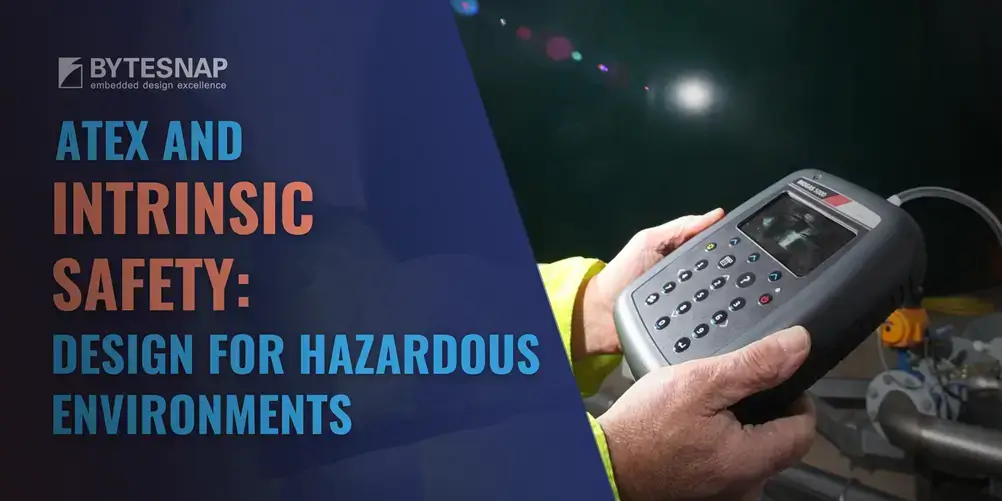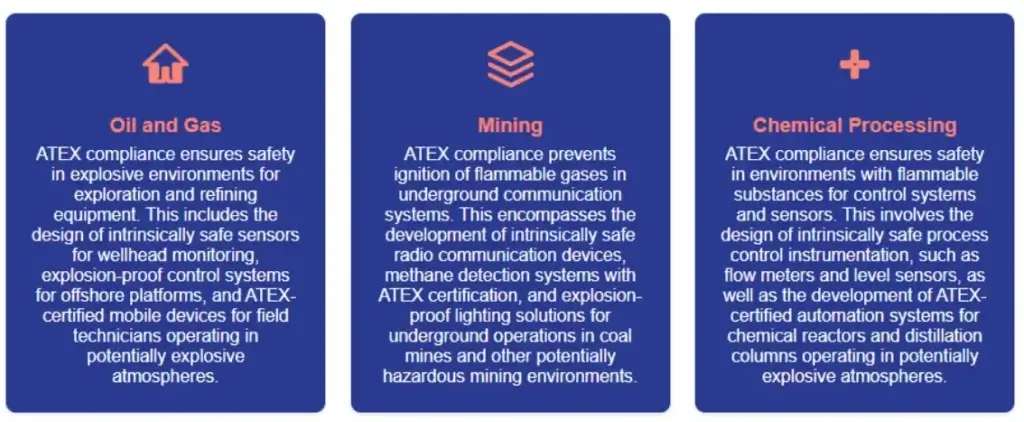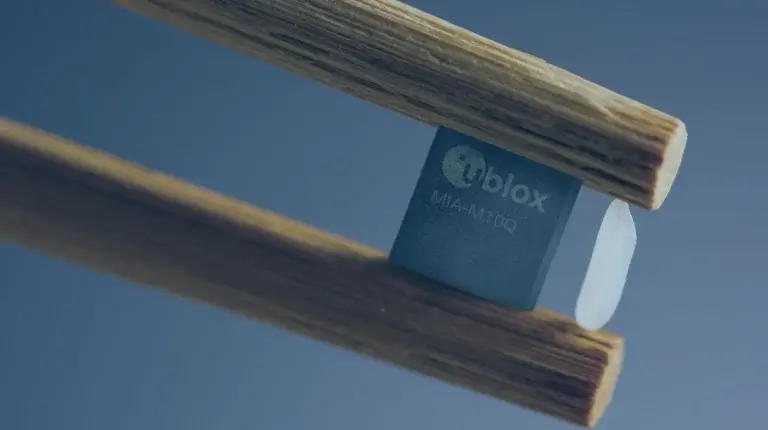ATEX and Intrinsic Safety: Designing for Hazardous Environments
In today’s complex industrial landscape, ensuring safety in hazardous environments is of paramount importance.
This article covers the intricacies of ATEX directives and intrinsically safe product design, for industries operating in potentially explosive atmospheres.
The implementation of these standards and design principles is essential for mitigating risks associated with explosive gases, vapours, mists, and combustible dusts in various industrial settings.

Understanding ATEX and Intrinsic Safety
ATEX (ATmosphères EXplosibles) directives are stringent European Union standards governing equipment and protective systems used in potentially explosive atmospheres.
These directives, specifically 2014/34/EU for equipment and 1999/92/EC for worker protection, provide a comprehensive framework for ensuring safety in hazardous areas.
Intrinsic safety, a fundamental concept within ATEX, is a sophisticated design approach that meticulously limits electrical and thermal energy to prevent ignition in hazardous areas.
This approach involves complex calculations and considerations of energy storage in capacitors and inductors, as well as the implementation of safety barriers and galvanic isolation techniques to ensure that even under fault conditions, the circuit remains incapable of causing ignition.
ByteSnap Design specialises in ATEX and intrinsically safe product design, offering expert services to ensure compliance and safety in hazardous environments. Our team of highly skilled engineers possesses in-depth knowledge of ATEX directives, IEC standards, and intrinsic safety principles, enabling our engineers to deliver robust hazardous area equipment design with precision and expertise.
Key Considerations in ATEX Product Design
Designing for ATEX compliance involves several critical factors that require meticulous attention to detail and a thorough understanding of explosion protection techniques:
- Understanding Hazardous Environment Classifications: This includes a complrehensive analysis of Zone 0, 1 and 2 for gases, and Zones 20, 21 and 22 for dusts - as well as equipment categories 1, 2, and 3.
- Compliance with ATEX and IECEx Standards: This involves adherance to specific standards, such as EN 60079 series for electrical equipment in explosive atmospheres, and EN 1127-1 for explosion prevention and protection.
- Low Power Design Principles for Intrinsic Safety: Implementation of energy-limiting techniques, such as voltage and current limiting circuits and the use of safety barriers to restrict available power in the circuit.
- Proper Component Selection and Circuit Design: Use of components rated for hazardous environments, implementation of redundancy in critical circuits and careful consideration of compnent spacing and creepage distances.
- Enclosure and Material Considerations: Selection of appropriate materials that prevent ststic build-up, ensure proper heat dissipation and maintain integrity under extreme conditions, including the use of special plastics, metal alloys and anti-static coatings.
Software Development for ATEX-Compliant Products
Software plays a crucial role in ATEX-compliant products, requiring a rigorous approach to development and validation.
Key aspects include:
- Embedded systems and firmware considerations: Implementation of fault-tolerant architectures, use of redundant microcontrollers, and development of watchdog mechanisms to ensure system integrity.
- User interface design for hazardous environments: Development of intuitive interfaces that can be operated with personal protective equipment (PPE) and in challenging environmental conditions, often incorporating ruggedised touchscreens or explosion-proof input devices.
- Rigorous testing and validation processes: Implementation of formal verification methods, such as static code analysis and model checking, to ensure software reliability. This also includes extensive environmental testing to validate software performance under extreme conditions.
ByteSnap’s software development services encompass these critical areas to deliver robust and compliant solutions. Our software engineering team employs advanced development methodologies, including formal methods and model-driven development, to develop highly reliable and verifiable software systems for ATEX-compliant products.
Industry Applications and Case Studies
ATEX and intrinsically safe designs are crucial in various industries, each presenting unique challenges and requirements:

ByteSnap has extensive experience across these diverse market sectors, delivering tailored solutions for each unique environment.
Our portfolio includes successful implementations of ATEX-compliant systems in offshore oil platforms, underground mining operations, and chemical processing facilities, demonstrating our expert ability to address the specific challenges of each industry while maintaining the highest standards of safety and reliability.
Case Study: “Great Credentials, Proven Track Record”
Partnering with Experts: Ensuring Compliance and Safety
Developing ATEX-compliant and intrinsically safe products requires specialised knowledge and expertise beyond standard electronic design principles.
Partnering with engineering professionals like ByteSnap offers:
- Compliance with the latest ATEX directives: This includes staying abreast of evolving standards and implementing design strategies that anticipate future regulatory changes.
- Optimised design for intrinsic safety: Using advanced simulation tools and analytical techniques to model circuit behaviour under normal and fault conditions to verify that intrinsic safety is maintained in all scenarios.
- Efficient certification processes: Leveraging extensive experience with notified bodies and certification authorities to streamline the path to ATEX certification, including preparation of technical files and coordination of third-party testing.
ByteSnap’s comprehensive design solutions cover all aspects of ATEX and intrinsically safe product development, from concept to certification. Our multidisciplinary team combines expertise in electronic engineering, software development, and regulatory compliance to deliver holistic solutions that meet the stringent requirements of hazardous environment applications.
Essential Components of Intrinsically Safe Electronic Design
Intrinsically safe design focuses on preventing ignition sources in potentially explosive atmospheres through a multifaceted approach to circuit and system design.
Key components and techniques include the implementation of Zener barriers for voltage limitation, optocouplers for galvanic isolation, and intrinsically safe interfaces for communication between safe and hazardous areas.
The design must also consider the energy storage capabilities of reactive components, such as capacitors and inductors, so that even under fault conditions, the stored energy remains below the minimum ignition energy (MIE) of the hazardous atmosphere.
ByteSnap’s expertise in electronic board design and ATEX compliance ensures the development of safe and reliable products for hazardous environments. Our approach incorporates advanced PCB layout techniques, such as the use of guard rings and careful routing to maintain separation between intrinsically safe and non-intrinsically safe circuits.
Our award-winning team also employs sophisticated thermal management strategies and EMC considerations to guarantee the integrity of the intrinsically safe design under all operating conditions.
Conclusion: Safety Through Expert Design
ATEX and intrinsically safe product design are critical for ensuring safety in hazardous environments, requiring a nuanced understanding of explosion protection techniques and a commitment to rigorous design practices.
By understanding the key principles, leveraging expert knowledge, and partnering with experienced professionals like ByteSnap, companies can develop reliable and compliant products for these challenging settings.
As industries continue to evolve and operate in increasingly complex environments, the importance of specialised design for hazardous environments will only grow, making expertise in this field more valuable than ever.
The integration of advanced technologies, such as IoT and AI, into ATEX-compliant systems, presents new challenges and opportunities, further emphasising the need for continual innovation and expertise in this critical area of industrial safety.
Looking for ATEX or IS design support?

Dunstan is a chartered electronics engineer who has been providing embedded systems design, production and consultancy to businesses around the world for over 30 years.
Dunstan graduated from Cambridge University with a degree in electronics engineering in 1992. After working in the industry for several years, he co-founded multi-award-winning electronics engineering consultancy ByteSnap Design in 2008. He then went on to launch international EV charging design consultancy Versinetic during the 2020 global lockdown.
An experienced conference speaker domestically and internationally, Dunstan covers several areas of electronics product development, including IoT, integrated software design and complex project management.
In his spare time, Dunstan enjoys hiking and astronomy.




